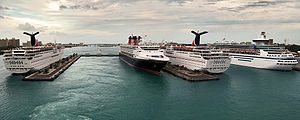Transport in the Bahamas
Golf carts are common in certain low traffic residential communities, resorts, and shopping areas away from main roads.[1] Privately operated licensed jitneys are the main mode of public transport and way to get around at a low cost, with rides ranging from $1 to 3.In 2017, the government launched a pilot programme to unify the different routes under one bus system among other improvements such as clearer signage and timetables.At Wilson City, Abaco, a mill plant and adjacent town was developed by the Bahamas Timber Company at a cost of around $1 million, including building 12 miles of railway for logging.At the last 4 camps, causeways were built so that the rail lines could reach the shore, over the vast expanses of swamp and mangroves.The locomotives were phased out eventually, but the tracks remained for a few more years before being removed due to contamination issued with the salt.There have been a handful of smaller railways that operated without locomotives, built for the purpose of transporting salt, sisal, and agricultural produce.The railroad was built in the 19th century to carry produce from Old Bight to a port where crops would be shipped to Europe and the US, and was closed when the US stopped foreign exports and plantations were no longer in use.

Bahamasarchipelagic stateAtlantic OceanhighwayGolf cartsNew Providencecar dependencyjitneysridesharingdispatch centreGreat AbacoMarinasharboursAbaco IslandsGreen Turtle CayMarsh HarbourTreasure CayWalker's CayBerry IslandsGreat Harbour CayBiminiAlice TownCat CaysEleutheraGovernor's HarbourHarbour IslandSpanish WellsGrand Bahama IslandFreeportLucayaWest EndInaguaMatthew TownLong IslandMayaguanaAbraham's BayNassauNew Providence IslandSan Salvadorcruise shipsGreat Stirrup CayNorwegian Cruise LineLittle Stirrup CayRoyal Caribbean InternationalCarnival Corporation'sLittle San Salvador IslandCastaway CayDisney Cruise Linetender boatsBahamas Maritime Authorityflag of convenienceList of airports in the BahamasairportsLynden Pindling International AirportGrand Bahama International AirportMarsh Harbour International AirportList of airlines of the BahamasBahamasairflag carrierheliportParadise Islandcruise lineWorld War IPineridgeWorld War IIWayback MachineThe BahamasarticlesHistoryColonial headsEleutheran AdventurersRaid of NassauRaid on Charles TownRaid on NassauRaid on Nassau (1720)Capture of the Bahamas (1782)Capture of the Bahamas (1783)SlaveryAmerican Civil WarGeographyCitiesCreeksIslandsGrand BahamamammalsPoliticsDefence ForceElectionsForeign relationsGovernor-GeneralLaw enforcementLocal governmentMonarchyParliamentBuildingConstituenciesPolitical partiesPrime MinisterEconomyAgriculture and fisheriesCommunicationsDollar (currency)Stock exchangeSquattingTaxationAnthemCoat of armsCreoleCultureEducationHolidaysLGBTQ rightsNational songPeopleDemographicsPledgeReligionTelevisionOutlineBibliographySovereignstatesAntigua and BarbudaArgentinaBarbadosBelizeBolivia